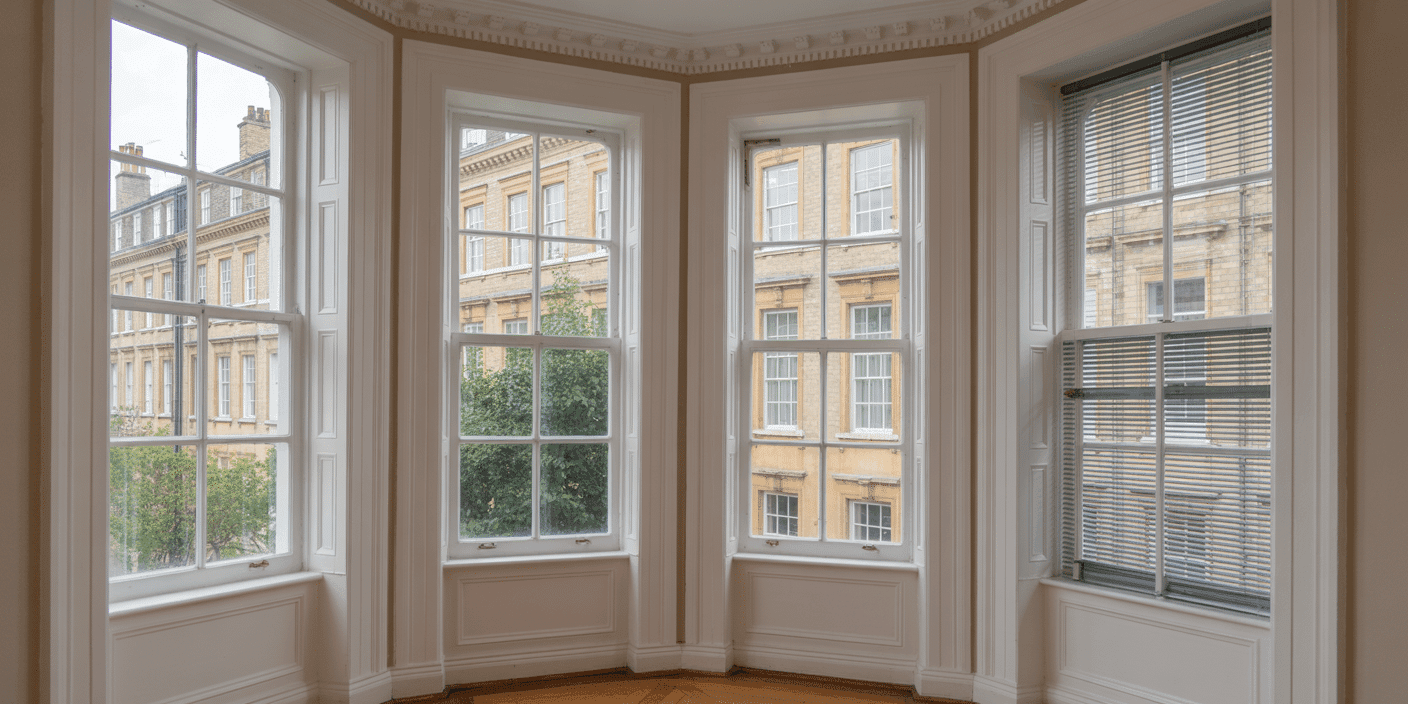The Cold Truth: Why London Homes Leak Heat (The Problem Nobody Talks About)
You feel the problem long before you understand it.
Cold floorboards at dawn.
A bay window that chills the entire room.
A radiator running harder than it should, yet never achieving the warmth you expect.
Most Londoners blame the weather, the age of the building or a tired boiler.
But the real cause sits directly in front of you, quietly draining heat every hour of the day:
the window frame.
Not the glazing.
Not the sealant.
Not a draught you can patch with tape or strips.
The frame itself acts as a direct thermal bridge between the warmth inside and the cold outside.
This is the part of the window almost no installer talks about.
For decades, the industry has sold “double glazing” as the universal cure for discomfort, while glass stopped being the primary source of heat loss long ago. In many homes, aluminium and poorly engineered timber frames leak more heat than the glass they hold.
The evidence is immediate.
Touch the frame on a cold London morning.
It feels exactly like the outdoor temperature because, thermally, it is the outdoor temperature. Heat travels through the frame with almost no resistance, leaving you with higher bills, colder rooms and the damp patches that form when warm indoor air meets a cold surface.
Older homes suffer most.
Victorian terraces, Edwardian semis and Georgian townhouses offer architectural beauty but almost no thermal protection. A cold frame in a cold climate becomes a persistent heat-loss pathway, and London is full of properties built long before thermal performance was even a consideration.
The uncomfortable truth is this: a window can look flawless yet perform poorly.
And that is precisely why the companies that understand the engineering of the frame — not just the appearance of the glass — are the ones solving the problem with consistency and permanence. The difference between a cold home and a warm one often comes down to a single component hidden inside the frame.
A thermal break.
An insulated barrier.
A deliberate interruption in the flow of heat.
To understand why it matters, you first need to understand what it does — and how it transforms the performance of the entire window.
What “Thermally Broken” Really Means (And Why It Changes Everything)
A window looks simple.
A frame. A piece of glass. A few locks and latches.
But behind that simplicity sits a detail that decides whether your home feels warm and dry — or cold and damp.
That detail is the thermal break.
It’s the quiet hero of modern window engineering, and very few homeowners ever hear about it. Yet it is the one feature that separates a “pretty window” from a “high-performance window.”
Here’s the plain-English version.
A thermally broken frame is built with two sections:
- an outer frame facing the weather, and
- an inner frame facing your room,
—and between them sits an insulating barrier, usually a rigid polyamide strip, that prevents heat from passing from one side to the other.
No metal-to-metal contact.
No direct path for heat to escape.
No “cold bridge” sucking warmth out of your room.
This barrier is only a few millimetres thick, but it changes the behaviour of the entire window. It stops conduction — the same way a coaster stops heat from transferring from a hot mug into a wooden table. The outer frame can be freezing while the inner frame stays warm to the touch.
That one small change transforms the entire experience of the window:
- The room feels warmer.
- The glass stays clearer.
- Condensation drops dramatically.
- Heating bills start behaving.
- Cold patches disappear.
- Mould struggles to take hold.
It also lets the window achieve much lower U-values — the metric Building Control cares about — without expanding the frame, altering the sightlines, or compromising the architecture of a London property.
This is where so many standard aluminium frames fall short. Without a thermal break, they behave like a solid bar of metal running from outside to inside. They cannot — and will never — hold warmth inside the home.
A thermally broken frame fixes the problem at its source. It turns the weakest part of the window into one of its strongest. And the companies that specialise in these systems, the ones who understand that performance begins with the frame, not the glass, are the ones giving London homeowners homes that finally feel modern, even if the brickwork is two hundred years old.
This is the engineering.
Next comes the benefit you’ll feel first — on your bill and in your bones.

Benefit #1: Lower Heat Loss & Smaller Heating Bills
The first thing a thermally broken frame fixes is the thing you feel most:
the relentless, invisible flow of heat leaving your home long before you want it to.
Every London homeowner has lived this.
You turn the heating on. The room warms up.
Then, like clockwork, the warmth drains away through the frames.
You’re not heating your home — you’re heating the street.
This isn’t sentimental exaggeration. It’s the unavoidable truth of physics.
A standard aluminium or poorly insulated timber frame works like a conductor.
Heat travels straight through it, from the warm interior to the cold exterior, as easily as water flowing downhill. A single cold-to-the-touch frame can undo the entire benefit of modern glazing.
A thermally broken frame stops that transfer instantly.
By separating the inner and outer metal with an insulated barrier, the frame no longer behaves like a heat pipe. It behaves like part of the thermal envelope. The inside stays warm. The outside stays cold. And the energy you’re paying for actually stays inside the room.
The effect is immediate:
- The room warms faster.
- The heat stays in the room longer.
- The boiler cycles less frequently.
- The temperature doesn’t “sink” after you switch the heating off.
It’s the kind of comfort people only recognise after they’ve felt it: a quiet steadiness in the air, a room that simply holds its warmth instead of leaking it. London’s gas prices make this more than a comfort upgrade — it’s a financial one.
Victorian bays that used to sit five degrees colder than the rest of the home finally stabilise.
Georgian terraces with draughty, replaced aluminium windows stop bleeding heat.
Basement flats, notorious for cold corners, feel livable again.
North-facing rooms, once punished by the weather, start behaving like normal spaces.
This is why architects specify thermal breaks as standard in any aluminium-based system. Not because it’s fashionable. Not because it’s technical. But because it solves the single largest source of heat loss in most modern window installations.
And it’s why the companies that understand thermal bridging — who design, manufacture, and install thermally broken systems with precision — are the ones giving London homeowners homes that finally feel worth the energy they burn.
Benefit #2 — Better Condensation Control
Condensation isn’t “just winter.”
It’s the physical proof that your window frame is colder than the air touching it.
When warm, moisture-heavy indoor air hits a cold frame, water forms. Every time.
And where water forms, mould follows.
A thermally broken frame changes that equation.
By keeping the inside section warm, it removes the cold surface the moisture wants to cling to. You stop seeing water pooling on sills. You stop smelling damp. You stop fighting black mould in corners — especially in children’s bedrooms, north-facing rooms, and Victorian bay windows that always seem to sweat.
For many London homes, especially pre-war terraces and converted flats, reducing condensation is the difference between a healthy home and one that quietly degrades behind the paintwork.
Benefit #3 — Higher EPC Ratings (Without Rebuilding the House)
London homeowners are beginning to feel the pressure: higher EPC expectations, stricter council requirements, and banks tightening mortgage conditions on low-performing homes.
Most people look to insulation, boilers or solar for improvement — but the EPC algorithm heavily weights window performance, especially the U-value of the frame.
A thermally broken system drops the overall U-value of the window, boosting the Energy Rating instantly. No scaffolding. No ripping out plaster. No months of disruption. Just an engineered frame doing exactly what Building Control wants it to do.
For landlords, it keeps properties lettable.
For sellers, it adds value.
For buyers, it creates confidence.
And for anyone upgrading pre-existing aluminium or uPVC systems, it’s often the single fastest route to a better EPC band.
Benefit #4 — A More Comfortable, Usable Home
This is the benefit people feel most but struggle to describe.
Comfort.
Steady warmth.
A room that doesn’t swing hot and cold throughout the day.
No cold plume of air falling off the frame onto your ankles.
No icy corner in the dining room.
No “don’t sit near the window” rule.
When the inner frame stops acting like a radiator in reverse, the room immediately behaves differently. The temperature equalises. Draughts calm down. The air feels stable rather than restless. You stop compensating with heavy curtains, door draught stoppers, or constantly adjusting the thermostat.
Lofts feel livable.
Extensions stop feeling like garden sheds.
Ground-floor flats finally hold heat.
Children’s rooms become warm enough to sleep in without extra heaters humming in the corner.
This is the everyday performance gain: the quality-of-life upgrade you didn’t know a window could deliver.
And the reason it works is simple.
Companies that specialise in thermally broken systems understand that comfort starts with the frame — the one part of the window most homeowners never inspect, and most installers never explain.
The engineering is modest.
The effect is not.
Benefit #5 — Reduced Noise Transmission (A Quieter London Home)
London is not a quiet city.
You don’t need to live on Oxford Street to know that.
A bus is accelerating outside. A lorry is reversing. A train running past at 4 a.m.
Even side streets have a constant hum.
Most homeowners assume soundproofing comes from the glass.
It does — partly.
But a surprising amount of noise travels through the frame itself.
A thermally broken frame disrupts that pathway.
The insulated barrier inside the profile adds mass, breaks up vibration transfer, and blocks the direct conduction of sound waves. It’s the difference between hearing a rumble and hearing almost nothing at all.
Homes near:
- main roads
- railway lines
- night buses
- flight paths
- pubs and late-night venues
feel dramatically calmer with insulated frames.
It’s not silence. But it is peace — the sort of peace you only notice once you’ve experienced it.
And once you’ve experienced it, you never want to go back.
Benefit #6 — Easier Compliance With Part L, Part Q & Future Energy Standards
Here’s the part most homeowners only discover too late:
Building Control isn’t looking at your glass.
They’re looking at your frame.
A frame that conducts heat fails Part L long before the glazing does.
And in London — where conservation, thermal performance and planning departments have very little patience — a failed U-value can stall a renovation for weeks.
Thermally broken systems remove the risk.
- Lower frame U-values → easier Part L compliance
- Multi-point locking options → smoother Part Q approval
- Better air tightness → fewer objections from Building Control
- Predictable thermal modelling → fewer surprises during sign-off
It’s one of the reasons architects prefer specifying thermally broken aluminium, alu-clad or composite systems. They know it passes the first time. They know the data is dependable. They know it keeps the project on schedule.
And the companies that have mastered these installations — the ones who understand the regulatory landscape, the borough sensitivities, the conservation pressures — are the ones quietly preventing delays before they happen.
Because in London, the difference between a “simple window upgrade” and a “six-week planning problem” is often the engineering hidden inside the frame.
A small break.
A small barrier.
But a massive difference in compliance, cost and calm.
Benefit #7: Longevity, Durability & The Long Game
A thermally broken window doesn’t just work better on day one.
It keeps working — year after year, winter after winter — long after standard frames have begun to fail.
This is the benefit high-end homeowners appreciate most, because it turns a window from a recurring expense into a long-term asset.
Longevity begins with something deceptively simple: the inner frame stays warm.
A cold frame attracts condensation.
Condensation attracts mould.
Mould stains paint, swells timber, corrodes metal and quietly destroys gaskets and adhesives.
Most London homeowners think they have a “damp problem.”
Often, they have a frame temperature problem — the kind that thermally broken systems eliminate at the source.
When the internal section of the frame no longer behaves like a refrigerated surface, the window stops degrading from the inside out. Hardware lasts longer. Paint lasts longer. Timber-clad interiors avoid the slow, softening damage caused by seasonal moisture. Even aluminium avoids the micro-corrosion that forms when warm, wet indoor air hits a cold metal surface.
Then there’s the material advantage.
Thermally broken systems use a polyamide barrier that is stronger than many metals, stable under extreme temperature swings, and resistant to the expansion–contraction cycles that undermine cheaper frames. It prevents the twisting and warping that can cause windows to stick, rattle, gap or lose airtightness after a few years.
In composite and alu-clad systems, the performance goes even further:
- timber on the inside for warmth, beauty and insulation
- Aluminium on the outside for weather resistance
- a thermal break in between to stop heat loss
It’s an architectural three-act play — and each material performs the part it is best at.
This is why architects specify these systems for projects expected to last decades, not seasons.
Why developers choose them for premium retrofits.
Why homeowners who are tired of replacing draughty, failing frames choose them the second time around instead of repeating the same mistake.
Because longevity isn’t a feature — it’s an economy.
A window that performs for 30–40 years without warping, leaking heat or collecting mould pays for itself in lower maintenance, fewer call-outs and a property that holds (or even increases) its value.
And behind the scenes, companies who specialise in thermally broken systems — the ones who understand how to engineer the frame, seal it properly, and install it with precision — are the ones giving London homes that long-term stability. They know the climate. They know the housing stock. They know how moisture behaves in a Victorian bay or a Georgian sash box.
A standard window looks good for a year.
A thermally broken system stays good for decades.
That’s the difference between buying a product and investing in your home.
When Thermally Broken Windows Matter Most (The Filters That Make the Decision For You)

There are moments in a London home when “better windows” stop being a nice idea and start becoming the only sensible choice.
Not because of fashion. Not because of technology.
But because the house itself demands it.
Thermally broken windows rise to the top of the shortlist in seven specific scenarios — situations London homeowners face every day.
If you recognise even one of them, the upgrade isn’t a luxury. It’s the corrective measure your home has been waiting for.
1. When You Live in a Victorian, Georgian or Edwardian Home That’s Always Cold
London’s heritage streets are beautiful.
They are also some of the least insulated in Europe.
Solid walls, exposed bays, and oversized frames mean heat loss is built into the architecture. A cold frame makes everything worse.
A thermally broken system is often the only way to bring these homes to modern comfort without altering sightlines or heritage character.
2. When Condensation Appears Every Winter — Especially in Bedrooms
If your sills pool with water.
If your corners darken with mould.
If children’s rooms smell slightly damp by February.
This isn’t “normal winter behaviour.”
It is the unavoidable outcome of a cold frame meeting warm indoor air.
A thermal break stops condensation at its source, not with wipes or sprays.
3. When Your EPC Rating Is Holding Back Your Plans
Selling?
Letting?
Remortgaging?
Planning an extension?
London’s EPC pressures apply to all of them.
A thermally broken frame is one of the fastest ways to shift a band without ripping open walls or upgrading mechanical systems.
It is a compliance shortcut that doesn’t feel like a shortcut.
4. When Noise Is Stealing the Quiet Moments in Your Own Home
London hums, rattles, screeches and reverses.
Glass matters, but frames transmit sound too — more than most people realise.
Homes near busy roads, rail lines, schools, night buses or early-morning delivery routes feel dramatically calmer once the frame stops carrying vibration indoors.
It’s not soundproofing.
It’s sanity preservation.
5. When You’re Planning a Loft, Extension or Garden Room
These are the spaces that misbehave first.
Roofline exposures, single-aspect walls and high airflow make ordinary frames struggle.
A thermally broken system prevents the classic pattern:
warm kitchen → freezing extension → overheated loft → cold again by evening.
It makes the new square metres feel like part of the house, not an afterthought.
6. When You Live in a Conservation Area and Can’t Compromise the Look
Conservation officers rarely object to performance.
They object to bulky frames, clumsy sightlines and modern proportions forced onto heritage façades.
Thermally broken alu-clad or composite systems allow you to keep the traditional lines while hiding modern engineering inside.
It’s the only way to get performance without apology.
7. When Your Current Frames Are Aluminium or “Look Fine But Feel Cold”
Aluminium without a thermal break is architectural sabotage.
It looks sleek, modern and expensive — and behaves like an ice bar bolted to your wall.
If the frame is cold to the touch, the room will always fight to stay warm.
A thermally broken system ends that fight permanently.
You know your home better than anyone.
And if even one of these scenarios feels familiar, the thermal break isn’t a premium feature — it’s the missing piece.
The detail that makes the rest of the house behave.
The line between “it’s fine” and “this feels right.”
And in London — with its damp winters, strict regulations, heritage constraints and unforgiving energy bills — that line matters more than ever.
The Upgrade London Homes Actually Need
If your home feels colder than it should…
If the windows bead with condensation every winter…
If the heating runs harder than your patience… you’re not imagining it.
Your frames are giving up long before the rest of the house does.
A thermally broken window doesn’t just warm a room.
It transforms the way a London home behaves.
It stops heat loss at the source, steadies the temperature, quietens the noise, lifts the EPC rating, and protects the house from the slow, silent damage caused by cold surfaces and trapped moisture.
Most companies will talk about double glazing.
Some will talk about U-values.
Few will talk about the frame — the part of the window that decides whether your investment performs or disappoints.
This is where Sash Windows London stands apart without ever needing to say so.
They understand the climate.
They understand the quirks of Victorian brickwork and Georgian proportions.
They understand the pressure of Part L, the demands of conservation officers, and the frustration of paying for heat that doesn’t stay in the room.
What they build — and what they install — is engineered to solve the problem properly.
Not cosmetically.
Not temporarily.
Permanently.
So if your home feels cold, damp or expensive to heat, it’s time to stop guessing.
A survey will tell you, with absolute clarity, how much heat your frames are leaking and what a thermally broken system could save you — in energy, in comfort, and in the long-term health of the property.
Book a survey with Sash Windows London.
Discover what a warm, quiet, compliant London home actually feels like.
One small barrier inside the frame.
One major difference in the way you live.







